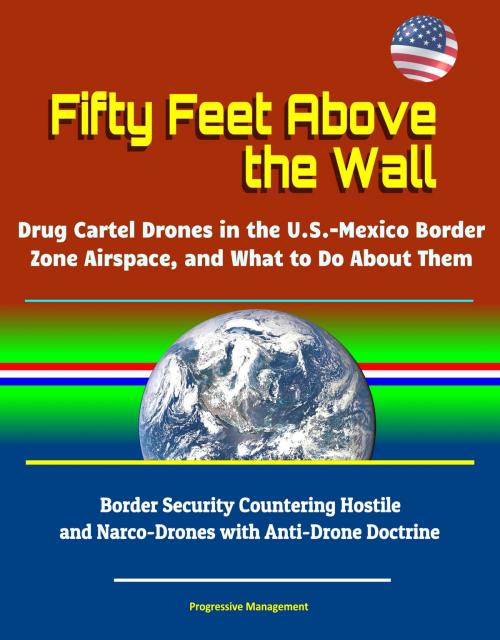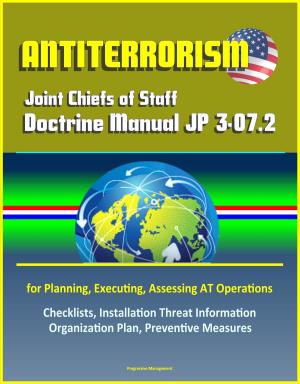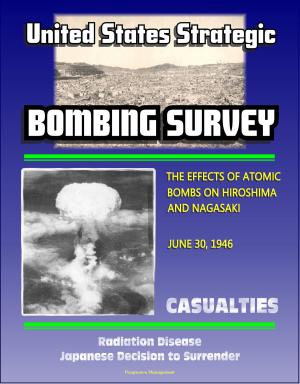Fifty Feet Above the Wall: Drug Cartel Drones in the U.S. - Mexico Border Zone Airspace, and What to Do About Them - Border Security Countering Hostile and Narco-Drones with Anti-Drone Doctrine
Nonfiction, History, Americas, Mexico, Military, Aviation| Author: | Progressive Management | ISBN: | 9780463610893 |
| Publisher: | Progressive Management | Publication: | June 8, 2018 |
| Imprint: | Smashwords Edition | Language: | English |
| Author: | Progressive Management |
| ISBN: | 9780463610893 |
| Publisher: | Progressive Management |
| Publication: | June 8, 2018 |
| Imprint: | Smashwords Edition |
| Language: | English |
This excellent 2018 report has been professionally converted for accurate flowing-text e-book format reproduction.
Over the last decade, the U.S. military and homeland security research groups have contemplated the issue of how to counter unmanned drones. Recently, border security agencies responsible for securing the U.S.-Mexico border are having to contend with the emerging threat of Mexico's drug cartel narcotics-smuggling drones, also known as narco-drones. Narco-drones are an example of cartel innovation for smuggling, among other deviant purposes, that U.S. border security will need a strategy to counter. This study aimed to build on the conceptual framework related to hostile drones in the airspace and specifically to find a strategy that the Department of Homeland Security could pursue to manage the narco-drone problem in the border-zone airspace.
The author argues that the Mexican drug cartels adopt innovative drone tactics in response to border security measures or lack thereof, as well as through organizational learning. This study concludes that leveraging U.S. military experience, anti-drone doctrine, and detection assets developed for countering terrorist drones in the war zones of Iraq, Syria, and Afghanistan is an effective strategy for countering narco-drones at the U.S.-Mexico border.
I. INTRODUCTION * A. RESEARCH QUESTION * B. ON BORDER WALLS * C. PROBLEM STATEMENT * D. LITERATURE REVIEW * 1. Narco-Drone Defined * 2. Game Changer? * 3. Drone Threat Scenarios DHS Should Consider * 4. Department of Homeland Security and Department of Defense Overlap * 5. Policing the Borderland Airspace * 6. Evolution and Innovation of Drone Smuggling * E. METHODS AND SOURCES * F. BACKGROUND * II. DRONE THREAT: PREPARING FOR THE INEVITABLE * A. WHAT IS A NARCO-DRONE? * B. DRONE CATEGORY (ARMY) * C. TACTICAL TO PRACTICAL OR THE OTHER WAY * D. THE QUINTESSENTIAL DRUG MULE * E. EYE IN THE SKY * F. TARGETED ATTACK * G. DRONE CAPABILITIES AND LIMITATIONS * 1. DJI Spreading Wings S900 * 2. DJI Matrice 600 Pro * H. NARCO-DRONE INNOVATION FACTORS * 1. Payload * 2. Range * 3. Weatherproofing * 4. Imaging * 5. Assumptions Going Forward * 6. Conclusions * III. UNDERSTANDING AIRSPACE CONTROL AND CONTROLLED AIRSPACE * A. INTERNATIONAL LAW AND AIRSPACE SOVEREIGNTY * B. AIRSPACE SOVEREIGNTY * C. UNCONTROLLED AIRSPACE * D. INTERNATIONAL COMMERCIAL DRONE REGULATION * E. FAA REGULATORY FRAMEWORK FOR DRONES * F. FAA CALLING ON INNOVATORS * G. LEGALITY OF DRONE COUNTERMEASURES * H. DRONE-THREAT COUNTERMEASURE APPROACH * I. LAYERED DEFENSE AND DEFENSE IN DEPTH * J. MILITARY PERSPECTIVE ON DEFENSE IN DEPTH * K. OPERATIONAL CONTROL * 1. Border Patrol and Operational Control * 2. Operational Control Definition Remains Elusive * IV. DRUG CARTEL INNOVATION BEHAVIOR * A. DRUG CARTELS CARE ABOUT SUPPLY CHAINS * B. DRUG CARTELS ARE SIMILAR TO BUSINESS CORPORATIONS * C. THE DEMOCRATIZATION OF AIRSPACE * D. LOW-COST, EASY TO USE, WIDELY AVAILABLE * E. MEXICO'S DRUG CARTELS COULD BE LEARNING FROM TERRORIST DRONE SUCCESSES * V. DRONE DETECTION AND COUNTERMEASURES * A. AIR INTERDICTION OF NARCO-PLANES * B. DOD DRUG INTERDICTION * C. DETECT AND TRACK AIRCRAFT * D. TETHERED AEROSTAT RADAR SYSTEM (TARS) * E. U.S. ASSISTANCE TO MEXICO'S RADAR CAPABILITY * F. DRONE DETECTION IN URBAN AREAS * G. PASSIVE COUNTERMEASURES * H. ACTIVE COUNTERMEASURES * I. AERIAL DRUG INTERDICTION CAPABILITIES MAY BE DOOMED TO FAIL * VI. CONCLUSIONS * A. THE THREAT * B. AIRSPACE CONTROLS * C. CARTEL INNOVATION * D. COUNTER-DRONE STRATEGIES * E. FUTURE RESEARCH
This excellent 2018 report has been professionally converted for accurate flowing-text e-book format reproduction.
Over the last decade, the U.S. military and homeland security research groups have contemplated the issue of how to counter unmanned drones. Recently, border security agencies responsible for securing the U.S.-Mexico border are having to contend with the emerging threat of Mexico's drug cartel narcotics-smuggling drones, also known as narco-drones. Narco-drones are an example of cartel innovation for smuggling, among other deviant purposes, that U.S. border security will need a strategy to counter. This study aimed to build on the conceptual framework related to hostile drones in the airspace and specifically to find a strategy that the Department of Homeland Security could pursue to manage the narco-drone problem in the border-zone airspace.
The author argues that the Mexican drug cartels adopt innovative drone tactics in response to border security measures or lack thereof, as well as through organizational learning. This study concludes that leveraging U.S. military experience, anti-drone doctrine, and detection assets developed for countering terrorist drones in the war zones of Iraq, Syria, and Afghanistan is an effective strategy for countering narco-drones at the U.S.-Mexico border.
I. INTRODUCTION * A. RESEARCH QUESTION * B. ON BORDER WALLS * C. PROBLEM STATEMENT * D. LITERATURE REVIEW * 1. Narco-Drone Defined * 2. Game Changer? * 3. Drone Threat Scenarios DHS Should Consider * 4. Department of Homeland Security and Department of Defense Overlap * 5. Policing the Borderland Airspace * 6. Evolution and Innovation of Drone Smuggling * E. METHODS AND SOURCES * F. BACKGROUND * II. DRONE THREAT: PREPARING FOR THE INEVITABLE * A. WHAT IS A NARCO-DRONE? * B. DRONE CATEGORY (ARMY) * C. TACTICAL TO PRACTICAL OR THE OTHER WAY * D. THE QUINTESSENTIAL DRUG MULE * E. EYE IN THE SKY * F. TARGETED ATTACK * G. DRONE CAPABILITIES AND LIMITATIONS * 1. DJI Spreading Wings S900 * 2. DJI Matrice 600 Pro * H. NARCO-DRONE INNOVATION FACTORS * 1. Payload * 2. Range * 3. Weatherproofing * 4. Imaging * 5. Assumptions Going Forward * 6. Conclusions * III. UNDERSTANDING AIRSPACE CONTROL AND CONTROLLED AIRSPACE * A. INTERNATIONAL LAW AND AIRSPACE SOVEREIGNTY * B. AIRSPACE SOVEREIGNTY * C. UNCONTROLLED AIRSPACE * D. INTERNATIONAL COMMERCIAL DRONE REGULATION * E. FAA REGULATORY FRAMEWORK FOR DRONES * F. FAA CALLING ON INNOVATORS * G. LEGALITY OF DRONE COUNTERMEASURES * H. DRONE-THREAT COUNTERMEASURE APPROACH * I. LAYERED DEFENSE AND DEFENSE IN DEPTH * J. MILITARY PERSPECTIVE ON DEFENSE IN DEPTH * K. OPERATIONAL CONTROL * 1. Border Patrol and Operational Control * 2. Operational Control Definition Remains Elusive * IV. DRUG CARTEL INNOVATION BEHAVIOR * A. DRUG CARTELS CARE ABOUT SUPPLY CHAINS * B. DRUG CARTELS ARE SIMILAR TO BUSINESS CORPORATIONS * C. THE DEMOCRATIZATION OF AIRSPACE * D. LOW-COST, EASY TO USE, WIDELY AVAILABLE * E. MEXICO'S DRUG CARTELS COULD BE LEARNING FROM TERRORIST DRONE SUCCESSES * V. DRONE DETECTION AND COUNTERMEASURES * A. AIR INTERDICTION OF NARCO-PLANES * B. DOD DRUG INTERDICTION * C. DETECT AND TRACK AIRCRAFT * D. TETHERED AEROSTAT RADAR SYSTEM (TARS) * E. U.S. ASSISTANCE TO MEXICO'S RADAR CAPABILITY * F. DRONE DETECTION IN URBAN AREAS * G. PASSIVE COUNTERMEASURES * H. ACTIVE COUNTERMEASURES * I. AERIAL DRUG INTERDICTION CAPABILITIES MAY BE DOOMED TO FAIL * VI. CONCLUSIONS * A. THE THREAT * B. AIRSPACE CONTROLS * C. CARTEL INNOVATION * D. COUNTER-DRONE STRATEGIES * E. FUTURE RESEARCH















